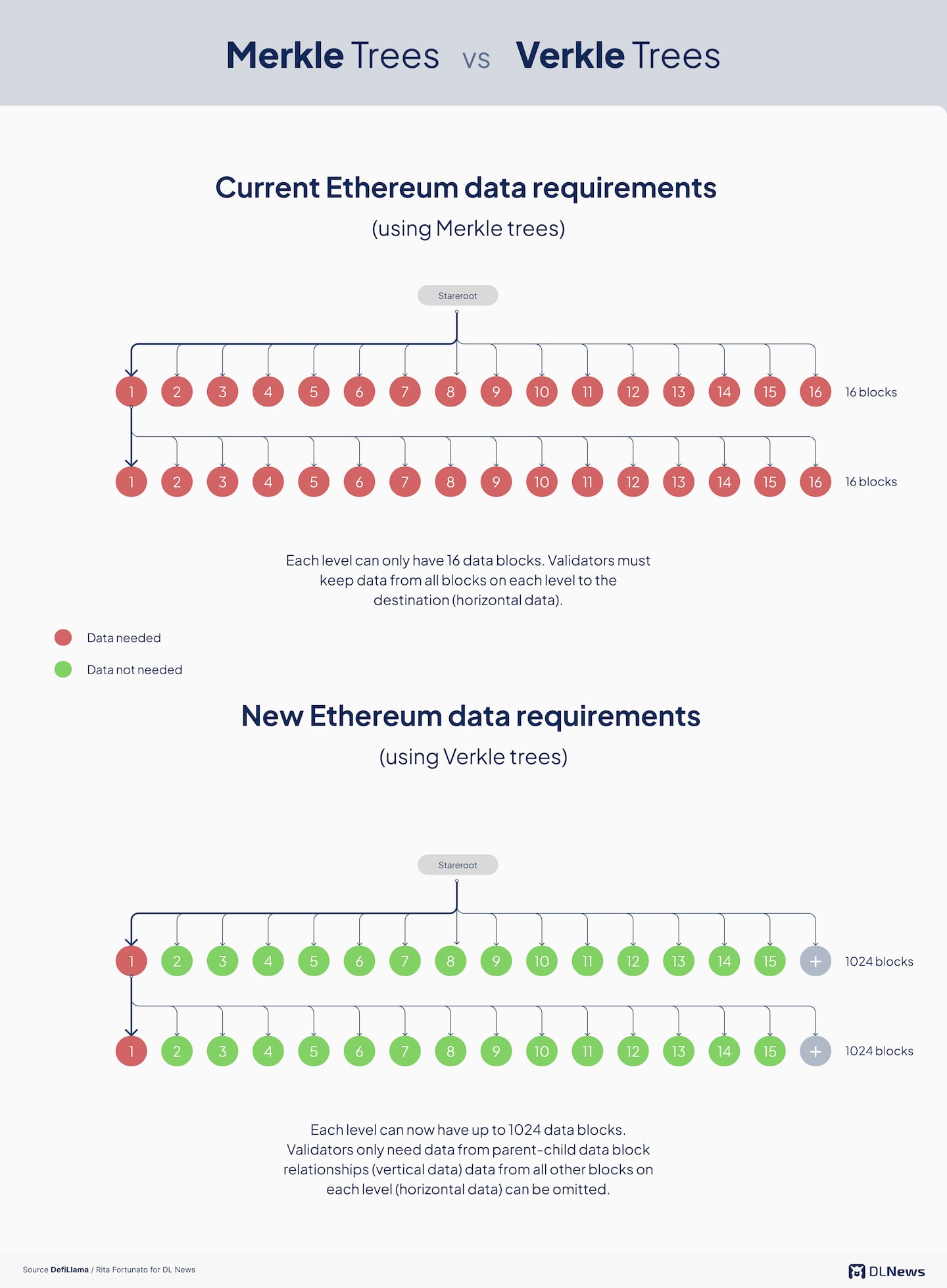An update already in the pipeline may vastly increase Ethereum’s decentralisation by slashing the amount of data needed to run infrastructure on the top smart contract network.
Currently, Ethereum validator nodes — pieces of software that help process and confirm transactions — must store large amounts of data locally to prove transactions they add to the blockchain are consistent with those that came before. That’s the “chain” in blockchain.
But with a cryptographic technique known among developers as Verkle trees, they will be able to create stateless nodes — infrastructure that doesn’t need a record of the blockchain’s state.
Ethereum core developer Preston Van Loon told DL News that stateless nodes would curtail the minimum requirement of between 500 and 800 gigabytes to run nodes to less than a single gigabyte.
“The goal of Verkle trees is not to save space in a full node, but to allow users to run them without any state at all,” Van Loon said.
He explained that with stateless nodes, users only need to keep a record of newer blocks that haven’t yet been finalised on the network. Verkle trees include something called a state witness that proves transactions are valid, so all other state data can be omitted.
“You can be assured that the state changes are valid with just the block and no local state,” Van Loon said.
“This is the biggest zero-to-one moment for Ethereum,” fellow Ethereum core developer Marius van der Wijden told DL News in an interview.
According to Van der Wijden, the biggest boon of stateless nodes is that individual Ethereum users will be able to verify the state of the network themselves, instead of relying on information from third parties.
At present, users without the resources or expertise to run their own nodes must rely on wallet providers such as MetaMask to confirm the blockchain’s state.
NOW READ: Aave stablecoin GHO struggles to hold dollar peg. ‘The focus on peg should come later,’ founder says
This reliance creates a single point of failure when interacting with Ethereum. It requires users to trust that MetaMask is reporting the state accurately. If MetaMask’s nodes go offline, or its state reporting is tampered with by a malicious actor, it can wreak havoc among users.
By reducing data costs, wallets will be able to build stateless nodes into their products that users can run locally, allowing them to easily verify Ethereum’s state.
“Every wallet can build this into their product and make sure their users are safe and following the correct chain,” Van der Wijden said.
Letting users verify Ethereum’s state isn’t the only problem stateless nodes might solve.
Currently, there are about 10,000 validator nodes keeping track of Ethereum’s state and producing new blocks. While this number is sufficient to protect the network from hostile takeover attempts, there are still centralised points of weakness.
For example, about 35% of Ethereum validator nodes are hosted via Amazon Web Services and share a single data centre in Ashburn, Virginia. If something were to happen to this data centre, it would impact the network, leaving it more vulnerable to attack.
NOW READ: Ethereum relies heavily on Amazon servers. Here’s why that’s a problem
Once Verkle trees make stateless nodes possible and wallets incorporate them into their products, Van der Wijden said he expects Ethereum may grow from 10,000 nodes to “millions” of stateless nodes.
Everyone can run these nodes,” he said. “They need a little bit of storage, they don’t need much memory, they need a little bit of bandwidth, but it could be that you can run these on your phone.”
Merkle vs Verkle
Currently, Ethereum relies on Merkle trees — a cryptographic technique that hashes a large number of chunks of data together. Merkle trees split data chunks into buckets, then take the hash of each bucket and combine them. This process is repeated until the total number of hashes remaining becomes only one — the root hash.
Still, Merkle trees need a lot of data. In order to verify the destination data chunk, validator nodes must keep all data from chunks on the same branch of the tree (parent-child data) and all data from each level leading to the specific chunk being verified (sister data).
Verkle trees, on the other hand, only need to keep parent-child data and can omit all sister data chunks. The result is nodes that can verify data without knowing the full state of the Ethereum blockchain.

According to Van der Wijden, the complex cryptography behind Verkle trees is solved, meaning that cryptographers have proven theoretically that their implementation works.
Converting Ethereum’s current Merkle tree architecture to Verkle trees while keeping the network running may be another matter.
“Converting the tree takes hours at least — maybe even days,” Van der Wijden said. He compared the complexity of the operation to last year’s Merge, the update that transitioned Ethereum from the energy-intensive Proof-of-Work consensus mechanism to the greener Proof-of-Stake.
Still, before Ethereum’s developers can seriously consider implementing Verkle trees, they must complete Cancun-Deneb, the next scheduled update.
NOW READ: Arbitrum and Optimism raked in $5.5m last month from fees. But they’re not spending it
Cancun-Deneb, among other things, introduces the highly anticipated EIP-4844, also known as Proto-Danksharding, an upgrade that should greatly reduce transaction costs on Ethereum layer 2 networks including Arbitrum and Optimism.
“Because this is such a big improvement, it makes sense for us to focus on [Verkle trees] over smaller, easier to implement proposals,” Van der Wijden said, adding that his voice is just one among many deciding the order of Ethereum updates.
“Many people are working on The Verge — the switch to Verkle trees — already,” Van Loon said. “I suspect it will be a high priority after Cancun.”
